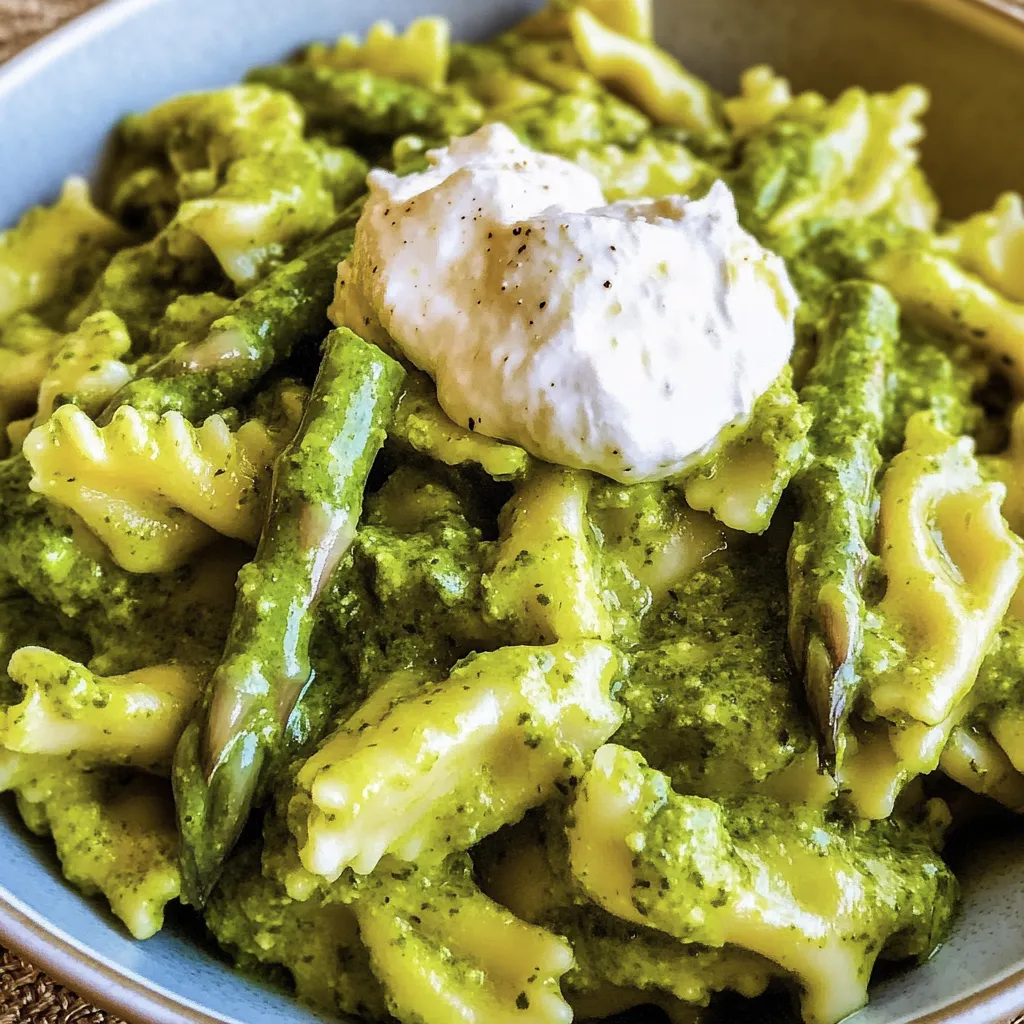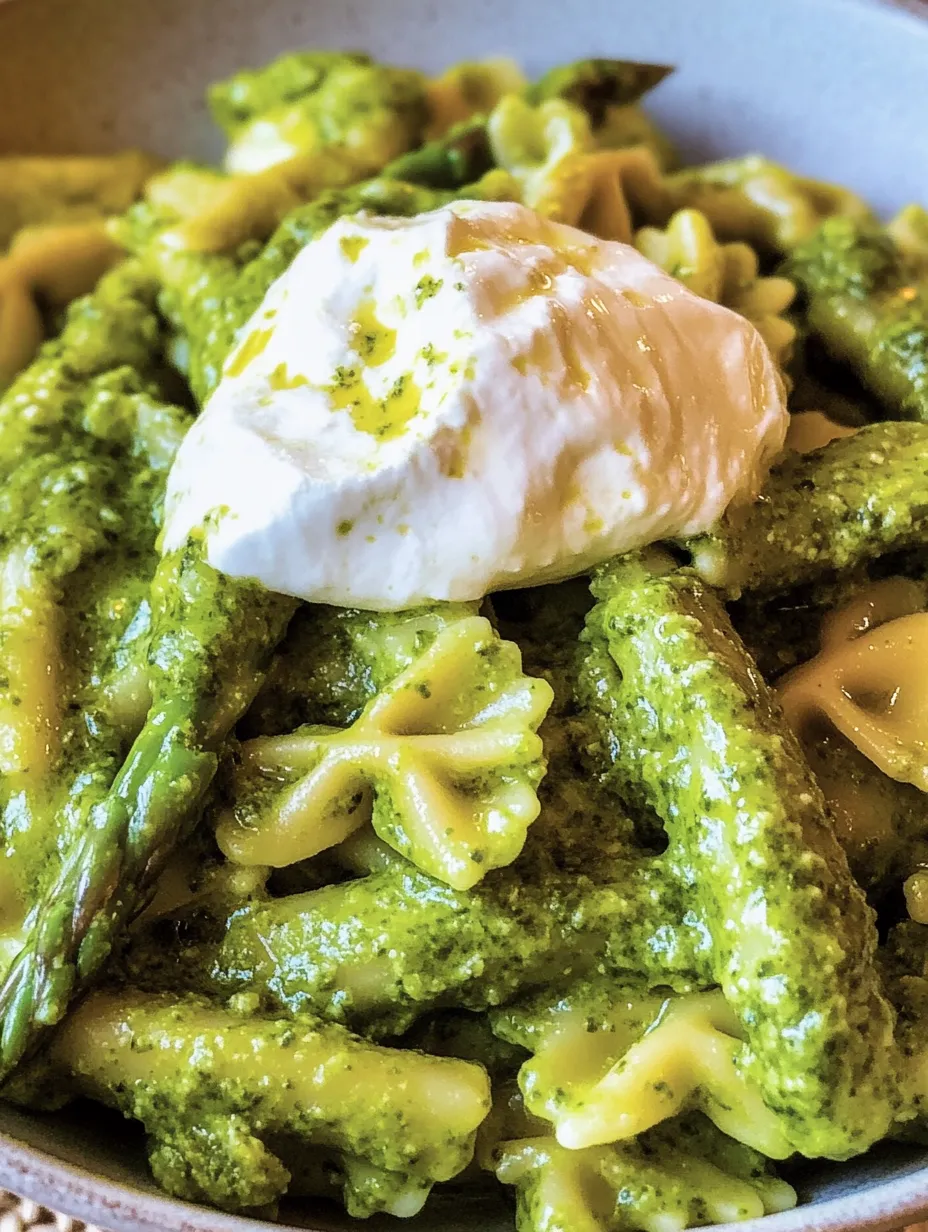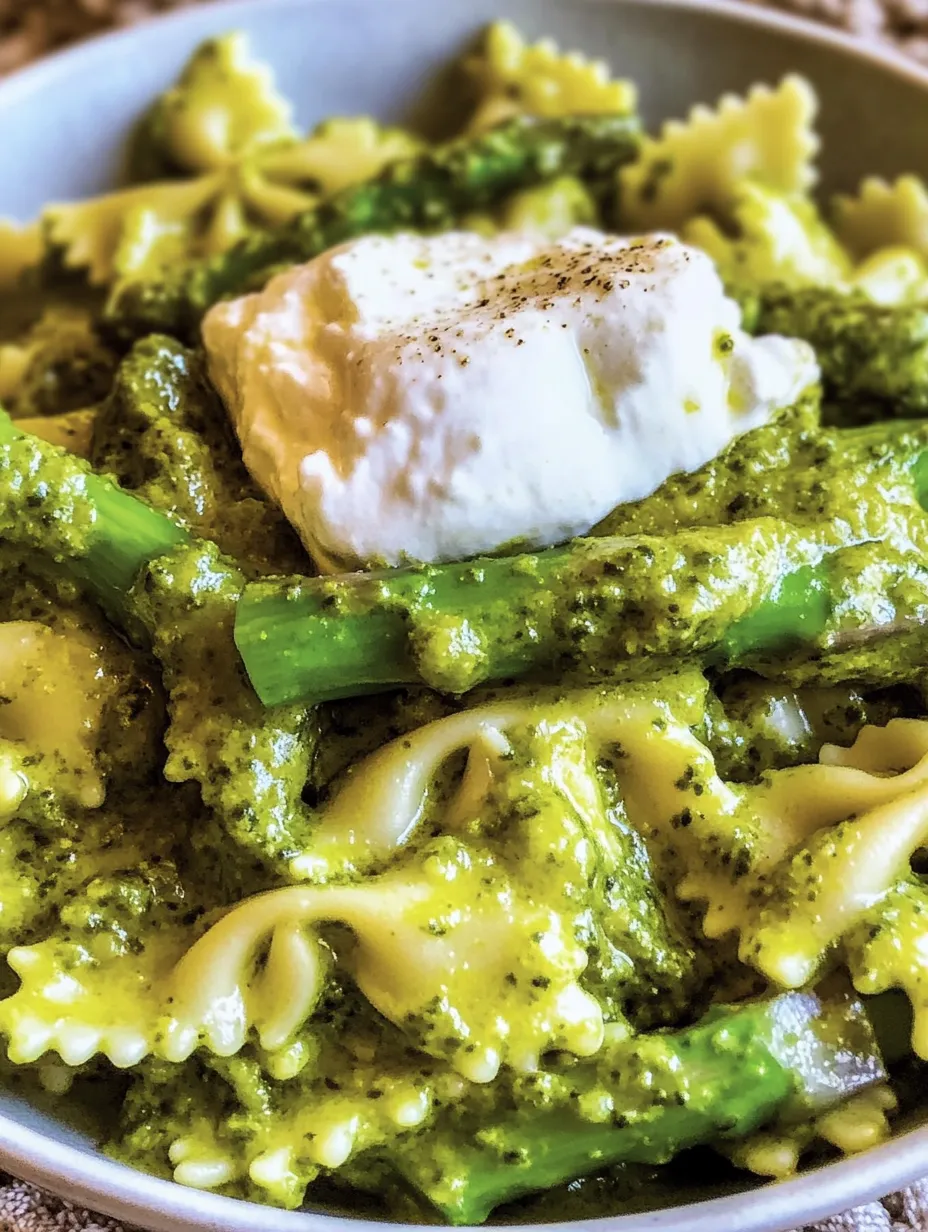 Pin it
Pin it
Tender green asparagus meets aromatic wild garlic pesto and creamy burrata in a composition that celebrates spring on a plate. This harmonious combination of savory, fresh, and creamy elements transforms simple pasta into a dish that appeals to all senses. The vibrant green colors and the enticing aroma make this pasta a culinary experience that delights both eyes and palate.
When I prepared this recipe for friends for the first time, there was silence at the table with the first bite – the clearest compliment a cook can receive. What particularly excites me about this dish is the simplicity of preparation in relation to the impressive result. The few, carefully selected ingredients complement each other perfectly and allow the characteristic flavor of each component to shine.
Flavor Symphony
- The mild-savory aroma of wild garlic: forms the aromatic base of the dish
- Crisp green asparagus: brings a fresh, slightly sweet note into play
- The creamy consistency of burrata: creates a luxurious melt on the tongue
- The nutty note of roasted pine nuts: sets punctual flavor accents
- The salty parmesan: intensifies all flavors and connects the components
- A hint of lemon: gives the dish a refreshing lightness
- The cream: softens the intense flavors and provides a velvety sauce
The magic of this dish lies in the balance between the individual components. While the wild garlic is savory and aromatic, the asparagus brings an elegant freshness. The burrata adds a creamy component that rounds out the dish and gives it a special texture. This harmonious combination makes every forkful a taste experience.
Ingredient Quality
- Fresh wild garlic: should have an intense aroma and vibrant green leaves
- Young green asparagus: with closed heads guarantees crisp texture
- High-quality burrata: with creamy interior ensures the perfect melt
- Extra virgin olive oil: gives the pesto its characteristic fruitiness
- Freshly grated parmesan: intensifies the umami flavor of the dish
- Untreated lemon: provides refreshing acidity and aromatic zest
- Pine nuts: should be golden-brown roasted for maximum flavor
- Al dente cooked pasta: perfectly captures the sauce
The quality of ingredients makes the decisive difference in this dish. I pay particular attention to fresh wild garlic that still has a strong aroma, and choose asparagus spears that break easily when bent – a sign of freshness. For the burrata, it's worth going to the delicatessen and asking for a handmade product whose creamy interior enticingly flows out when cut.
 Pin it
Pin it
Preparation Steps
- Prepare wild garlic pesto:
- Thoroughly wash the wild garlic and pat dry. Toast pine nuts in a pan without fat until golden brown and let cool. In a blender, process wild garlic, roasted pine nuts, grated parmesan, and olive oil into a creamy paste. Season with salt and pepper. The pesto should have a vibrant green color and a spreadable consistency.
- Prepare asparagus:
- Cut off the woody ends of the green asparagus. Depending on thickness, cut the spears diagonally into bite-sized pieces. Thin spears can remain whole. Sauté in a pan with a little olive oil over medium heat for about 3-4 minutes until crisp-tender. The asparagus should still have a slight bite and retain its bright green color.
- Cook pasta:
- Cook pasta in plenty of salted water according to package instructions until al dente. Before draining, reserve about half a cup of pasta water. The pasta should still have a bite as it will continue to cook slightly in the sauce later. The starchy pasta water later helps to bind the sauce creamily.
- Prepare sauce:
- Warm the wild garlic pesto in a large pan over low heat. Stir in cream or crème fraîche and simmer gently until a velvety sauce forms. Stir in grated parmesan and let melt. If needed, thin with some of the reserved pasta water until the desired consistency is reached.
- Combine components:
- Add the drained pasta to the sauce and mix well so that each pasta strand is coated with the sauce. Carefully fold in the sautéed asparagus. The heat should now be turned off so that the flavors can combine without the sauce thickening too much.
- Serve:
- Arrange the pasta on plates. Carefully divide the burrata into pieces and place on the pasta. Sprinkle with roasted pine nuts and drizzle with lemon juice if desired. Add freshly ground black pepper and possibly additional parmesan on top. Serve immediately while the burrata is still cool and the pasta is warm.
Spring Story
- Wild garlic: traditionally marks the beginning of the spring season in the kitchen
- Green asparagus: contains valuable vitamins and minerals that are particularly important after winter
- The combination of seasonal ingredients: conserves resources and guarantees intense flavor
In our family, this pasta has a special significance. Every year in April, when wild garlic sprouts in the forests, we take a family trip to collect it. My children have made a real competition out of who finds the most beautiful leaves. What particularly excites me about this dish is the connection to nature and the seasons. It only tastes truly perfect during these few weeks in spring when all ingredients are at their peak. This transience makes the dish something special that we look forward to all year.
Serving Suggestions
This spring pasta dish already shines on its own on the plate. For a complete menu, I recommend a light spring salad with radishes and young leaf spinach as an appetizer, whose freshness stimulates the appetite and perfectly sets the mood for the pasta. A dry white wine like a Sauvignon Blanc or a light Pinot Grigio harmonizes wonderfully with the fresh flavors as a drink. Its subtle acidity complements the creamy sauce and the savory notes of the wild garlic. To conclude the menu, a light dessert like marinated strawberries with lemon balm, which picks up the spring theme and refreshes the palate, is a perfect match.
Creative Variations
This basic composition leaves room for creative variations according to taste and preferences. For a more intense sea note, you can add sautéed prawns, whose sweet flavor harmonizes wonderfully with the wild garlic. A vegetarian alternative to burrata is smoked tofu, which gives the dish a savory depth. If you can't find wild garlic or want to cook outside the season, you can use a basil-arugula pesto, which offers similarly fresh flavors. For a completely vegan version, replace cream with coconut milk and parmesan with nutritional yeast flakes with a little salt – surprisingly delicious and still creamy.
 Pin it
Pin it
Storage Tips
This dish tastes best freshly prepared but can also be partially prepared in advance. The wild garlic pesto keeps in the refrigerator for up to a week when stored in a jar covered with a thin layer of olive oil. For longer shelf life, you can freeze it in portions, preferably in ice cube trays for easy dosing. The finished pasta should ideally be served immediately, as the burrata loses its creamy interior if it stands too long. If you do have leftovers, store them in an airtight container in the refrigerator and reheat carefully with a splash of cream to restore creaminess.
Kitchen Tricks
- The wild garlic pesto: only warming briefly preserves the vibrant green color and fresh aroma
- A few drops of lemon juice: in the pesto not only enhance the flavor but also keep the green color fresh longer
- The burrata: take from the refrigerator and divide only shortly before serving for the perfect temperature contrast
The discovery of this recipe has revolutionized my spring cuisine. What began as an experiment with freshly collected wild garlic has evolved into a ritual that marks the beginning of the warm season. Every time I prepare this dish, it reminds me of how important it is to cook with the seasons and respect the natural cycles. The intense flavor of fresh, seasonal ingredients cannot be replaced by anything. Try this recipe when wild garlic and asparagus are in their peak season, and experience how a simple pasta dish can become the embodiment of spring on your plate!
Frequently Asked Questions
- → Where can I find wild garlic and what should I look for?
- Wild garlic can be found in spring (March to May) at farmers' markets, well-stocked supermarkets, or from vegetable vendors. If collecting yourself, be very careful: wild garlic can be confused with poisonous plants like lily of the valley or autumn crocus. When in doubt, better buy it. The intense garlic-like smell is a good identifier for real wild garlic.
- → Can I prepare the wild garlic pesto in advance?
- Yes, the pesto keeps in the refrigerator for about 1-2 weeks if stored in a clean jar and covered with a thin layer of olive oil. It also freezes well - preferably in portions in ice cube trays. This way you can prepare this delicious dish even outside of wild garlic season.
- → Which pasta types work particularly well for this dish?
- For creamy sauces, pasta types that absorb the sauce well are suitable: spaghetti, linguine, fettuccine, or tagliatelle are good choices. But short formats like penne, fusilli, or orecchiette also work well, as the sauce collects in their twists and hollows.
- → Can I substitute something else for burrata?
- If you can't get burrata, you can also use regular mozzarella or buffalo mozzarella. These aren't as creamy inside but still complement the flavors well. Alternatively, ricotta or a dollop of mascarpone works to maintain the creamy component.
- → Can this dish be made vegan?
- Yes, for a vegan version you can replace the parmesan with vegan parmesan or nutritional yeast, use plant-based cream instead of dairy cream, and omit the burrata or replace it with vegan cream cheese. The dish loses some of its creaminess but is still very aromatic due to the wild garlic pesto.
- → How can I prepare the asparagus optimally?
- Green asparagus requires little cooking time. It's important to generously cut off the woody ends. The specified cooking time of 5-10 minutes is a guideline - depending on the thickness of the asparagus and personal preference, it can be cooked shorter or longer. It should still have a slight bite and not be too soft.
